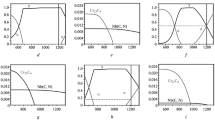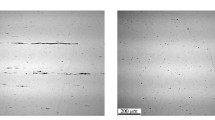Conclusions
-
1.
The effect of the interlayer on the diffusion redistribution of carbon in bimetals depends on the ratio of the activity coefficients and the effective diffusion coefficients of carbon in the components of the binetal. The interlayer is an effective barrier if the activity coefficients of carbon in it and in the components of the bimetal differ greatly. The effective diffusion coefficient of carbon in the interlayer should be smaller than in the components of the bimetal.
-
2.
For operation at 425–550°C for several thousand hours the most promising interlayers are those in which the carbon activity coefficient is at least 10 times larger than the carbon activity coefficient in the base layer.
-
3.
Operation at temperatures below 425°C and for short times (up to 1000 h) requires an interlayer with the minimal carbon activity coefficient (steel Kh25, for example).
-
4.
The use of steels with small amounts of carbide-forming elements as interlayers is inadvisable, since carbon migration occurs in the same way as in the bimetal without an interlayer during the course of operation.
-
5.
The protective properties of interlayers against redistribution of carbon in bimetals at high temperatures are also retained at lower temperatures (400–600°C).
Similar content being viewed by others
Literature cited
G. V. Shcherbedinskii et al., Zashchita Metal., No. 3 (1968).
I. A. Tomilin and L. A. Shvartsman, Zh. Fiz. Khim.,42, No. 3 (1968).
P. L. Gruzin et al., in: Problems of Metal Science and Physics of Metals [in Russian], No. 5, Metallurgiya, Moscow (1958).
M. A. Krishtal and V. D. Korvachev, in: Thermodynamics and Physical Kinetics of Structure Formation in Steel and Cast Iron [in Russian], Tul'skii Politekh. Inst., Tula (1967).
R. Smith, Trans. Met. Soc. AIME,218, No. 2 (1960).
I. I. Kovenskii, Fiz. Metal. Metalloved.,16, No. 4 (1963).
M. Nicholson, Trans. Met. Soc. AIME,224, No. 6 (1962).
Additional information
Central Scientific-Research Institute of Ferrous Metallurgy. Translated from Metallovedenie i Termicheskaya Obrabotka Metallov, No. 7, pp. 38–43, July, 1971.
Rights and permissions
About this article
Cite this article
Golovanenko, S.A., Konnova, I.Y. Selecting interlayers for corrosion resistant bimetals. Met Sci Heat Treat 13, 570–575 (1972). https://doi.org/10.1007/BF00648199
Issue Date:
DOI: https://doi.org/10.1007/BF00648199




